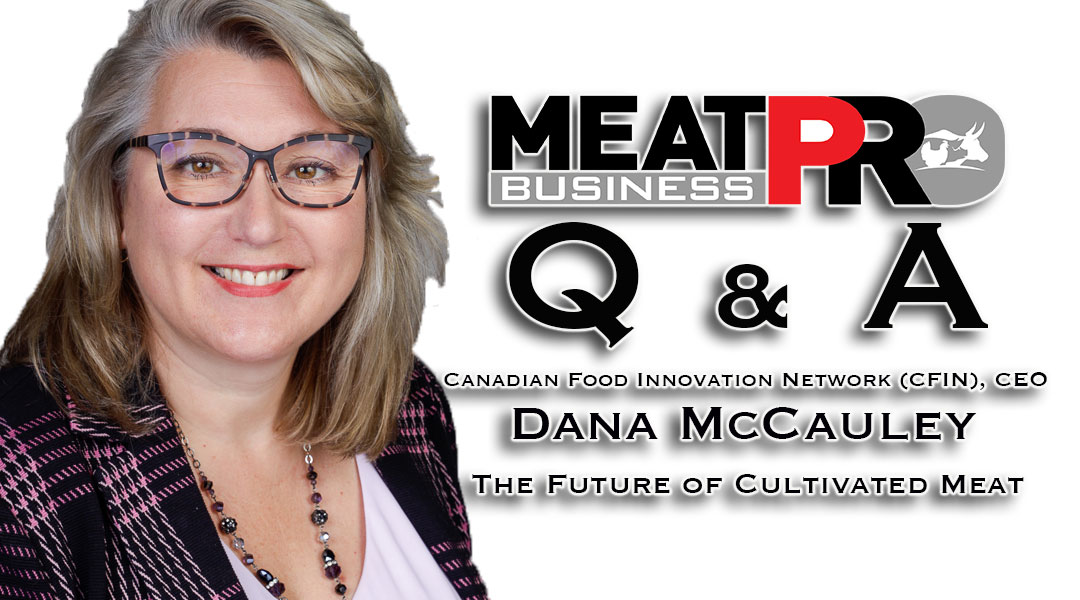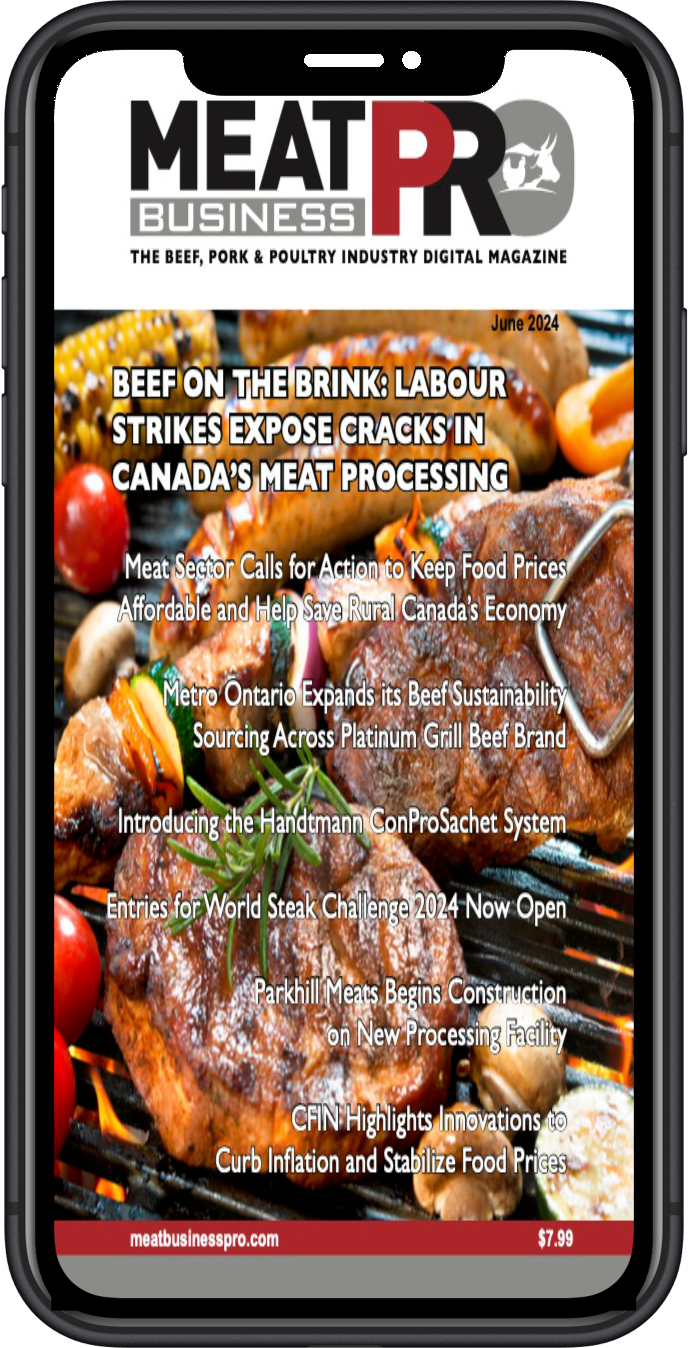The Future of Cultivated Meat

Meat Business Pro spoke recently with Dana McCauley, CEO of the Canadian Food Innovation Network (CFIN), one of this country’s top food industry experts. Our discussion focused on the status and future outlook for cultivated meat
An MBP Exclusive
With pressing issues surrounding climate change, greenhouse gases, animal welfare and transportation, a new product is beginning to make inroads to the meat industry.
Cultivated or cultured meat is in fact genuine animal meat that is produced by cultivating animal cells directly. This production method basically eliminates the need to raise and farm animals for food and does not require breeding or slaughtering animals.
The larger philosophical question becomes, what is the real future of meat cultivation? While this segment of the meat industry is very much in its early stages, it does require attention in terms of sustainability issues, food security, regulatory compliance, market growth and other challenges that are unknown at this time.
“We are also focused on educating people to mitigate the fear factor with positive messaging, explaining the difference between cellular foods, cellular agriculture, and cultivated meat”MBP: How long have you been with CFIN? And what interested you about it?
DM: I joined in August 2021 and I was employee number two. We wanted people to think of us as the place to go to find out about new innovations happening in the food business. But we differ from groups like the Good Food Institute in the U.S., who would be very interested in cellular food, but not so much in say robotics, whereas we are.
MBP: What are your thoughts of the analogy that cultivated meat is on the same level as electric vehicles? Even though it’s very much in its infancy, the long-term future of it looks very encouraging, especially for Canada.
DM: The numbers tell us there’s market opportunity, and so we have folks who want to learn and understand how this effectively fits into their business model. They’re generally people who are looking at global opportunities because in Canada we are protein sustainable. We produce enough meat for everybody in in this country because of our prairie grasses; we’re much more sustainable than Brazil or other protein producing countries. As we can see a world population of nearly 10 billion people that will have to be fed on the planet in the not so distant future, and their protein needs, then, yes, that’s an amazing export opportunity for Canada to set the standard in this sector.
MBP: How can this opportunity grow the market sector for other parts of the world, especially as the world’s population moves away from plant-based diets to protein-based diets? It seems to be an underserved market.
DM: We have biochemists, engineers, food scientists, geneticists, so yes we can create the foods and the equipment that other countries need. And we could easily pivot and start making bio reactors, for instance.
MBP: There are many positives that can come from this new technology for the meat industry as a whole that relate to animal welfare. What are your thoughts on that issue?
DM: Imagine if you are a rancher who has the best sires that create the most delicious meat, and now there’s this opportunity for you to sell your stem cells to a cellular food company. Imagine how that would help increase your profits while also providing a humane solution.
MBP: What are the current challenges facing this industry sector?
DM: One is a lack of capital. Those deep pockets that were burned on the planet-based meats are now more hesitant to jump in on innovative or alternative protein projects. Also a lack of capacity. Today, the largest bioreactor that I’m aware of in Canada is 10,000 litres. To have a national brand that’s in grocery stores, you would need several bioreactors operating 24/7. Here in Canada, capacity and money are the two predominant challenges we’re facing.
An offshoot challenge is when companies start going to other markets where they can get those two things, and subsequently encouraged to set up their headquarters in the U.S. or Singapore or Israel. As a result, we lose the potential tax benefit as well as the loss of job creating opportunities of having them be Canadian companies when that IP leaves our country.
We have a report coming out where we gauged consumer and media sentiment about these topics in both U.S. and Canada. We also tracked how IP generation and company formation is happening in both the U.S. and Canada. It clearly shows that the U.S. is much farther ahead of us.
MBP: How do you overcome this challenge of not being properly funded? Is there private money available or are there public organizations that provide grants or subsidy programs?
DM: CFIN has funded a lot of companies to do projects that will validate their value proposition and get them closer to market. In fact, one of the companies in a video we just released has a relationship with Upside Foods in the U.S. that just got approval to sell their chicken products.
There are a lot of partnership opportunities internationally where we’re starting to see saleable products. We are focused on helping these companies here in Canada to develop those relationships. One such group in Edmonton, Cult Food Science is very focused in this space. They’re working with the University of Alberta to develop, research and accelerate programs for these companies.
We are also focused on educating people to mitigate the fear factor with positive messaging, explaining the difference between cellular foods, cellular agriculture, cultivated meat, etc. We’re trying to use consistent language because if investors don’t understand what somebody’s saying, they’re going to feel uncomfortable putting their money into it. But the message is getting out there in the food industry.
I know that Agri-Food Canada are very interested in the lab grown meat and are meeting with groups like New Harvest, a not-for-profit started in the U.S. by Canadians.
MBP: Let’s shift to sustainability of lab grown meat. It’s safe to say right now, with the loss of grasslands and forest lands from wildfires this year, it’s not going to be long before livestock quotas are going to really suffer. Is there a forecast that you’ve had in any of your projections that give you an idea of how laboratory meat technology would have to ramp up to absorb conventional livestock loss?
DM: Canada is protein positive right now and is relatively sustainable in the way we produce beef. However, for this technology to fill a livestock gap, getting enough stem cells is the priority. I’m not sure we fully understand all the sustainability implications that will arise as the world becomes able to make cellular foods at scale. There are pros and cons with any technology. For instance, take the analogy between cellular foods and electric vehicles, if we want more nickel for EV batteries, that will result in open pit mining and that’s not good for the environment.
MBP: There’s also the concern is getting people to trust in technology generated food, which is a polarizing conversation.
DM: That is an important point. Last September, I sat on a panel at a Canadian Institute of Food Science and Technology event where we discussed how to frame the message so that people can see a benefit for themselves personally. Starting with nonmeat foods seems more palatable to consumers. For instance, an imported product like coffee could be a product to start with in Canada. Regardless, the product development challenges need to be surmounted so that the first foods people try meet their expectations. Even if we can create a steak that is bioidentical to one cut from a cattle carcus, the end product will need to have the familiar texture you know and enjoy while eating. In the end, that will require dozens of cellular produced products being combined in exactly the right way to replicate the muscle an animal creates naturally.
For more information on the Canadian Food Innovation Network, visit https://www.cfin-rcia.ca/home











